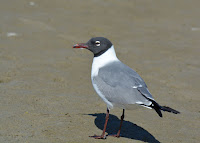LAUGHING GULL
LAUGHING GULL (Leucophaeus atricilla) – (See images below)
DESCRIPTION: The Laughing Gull in its breeding plumage has a black head, white under parts and neck, a grey back and wings, which are black at the tips. The gape is red. The tail is white in the adult, but has a black band in juveniles. Non-breeding adults have a white head. Sexes are similar. Except for the juveniles, the bill and legs remain dark red to reddish-black. The bird measures approximately 40 cm (16 in.) long.
VOICE: https://www.xeno-canto.org/species/Leucophaeus-atricilla – The laughing gull owes its name from its call that sounds like a human laugh.
NAME: The English name ‘Gull’ would have its origins in Old Celtic ‘Gullan’ and other languages, including Latin ‘gula’ for throat. As per Choate this would be related to the gull’s ‘indiscriminate’ scavenging habits, its ‘willingness to swallow almost anything’ (think ‘gullible’). The Latin genus name ‘Leucophaeus’ is from ancient Greek and means ‘dusky white’, in reference to the plumage color of this gull. The Latin species name ‘atricilla’ means ‘black tail’.
HABITAT: Mainly along the coast in bays, salt marshes and beaches, but also inland along rivers, in fields or at garbage dumps.
DIET: Laughing gulls are omnivorous. They will feed on insects, crustaceans, fish, small mammals, berries, and handouts from humans and garbage.
NESTING: Laughing gulls are social birds that breed in colonies that can be very large, and gather with other gulls, terns or pelicans.
DISTRIBUTION: The breeding range of this gull includes marshes on the coastal areas of the eastern and southern USA. Its wintering grounds include Mexico and the northern part of South America. Reported as a visitor in Hawaii.
DISTRIBUTION MAP: https://en.wikipedia.org/wiki/Laughing_gull#/media/File:Leucophaeus_atricilla_map.svg
ON PEI: The laughing gull does not breed on Prince Edward Island, and only a few sightings of this gull species have been reported in the last century.
GULLS ON HAWAII: Gulls are not long time residents or indigenous to Hawaii. They are continental species and the Hawaiian Islands don’t seem to provide them with the habitat they need. Those birds that do make it however have either flown on their own or got blown off course, or hitched a ride on ships. In either case they don’t stay for long.
CONSERVATION: Laughing gulls used to be hunted for their feathers and their eggs, but the population has well recovered to the point where it is now common, and listed as ‘least concern’. However the habitat of this species is vulnerable to beach development.
SIMILAR SPECIES: Bonaparte’s Gull, Black-headed Gull
REFERENCES: http://www.arkive.org/laughing-gull/larus-atricilla/
https://en.wikipedia.org/wiki/Laughing_gull
https://www.allaboutbirds.org/guide/Laughing_Gull/id
https://identify.whatbird.com/obj/539/overview/Laughing_Gull.aspx
DESCRIPTION: The Laughing Gull in its breeding plumage has a black head, white under parts and neck, a grey back and wings, which are black at the tips. The gape is red. The tail is white in the adult, but has a black band in juveniles. Non-breeding adults have a white head. Sexes are similar. Except for the juveniles, the bill and legs remain dark red to reddish-black. The bird measures approximately 40 cm (16 in.) long.
VOICE: https://www.xeno-canto.org/species/Leucophaeus-atricilla – The laughing gull owes its name from its call that sounds like a human laugh.
NAME: The English name ‘Gull’ would have its origins in Old Celtic ‘Gullan’ and other languages, including Latin ‘gula’ for throat. As per Choate this would be related to the gull’s ‘indiscriminate’ scavenging habits, its ‘willingness to swallow almost anything’ (think ‘gullible’). The Latin genus name ‘Leucophaeus’ is from ancient Greek and means ‘dusky white’, in reference to the plumage color of this gull. The Latin species name ‘atricilla’ means ‘black tail’.
HABITAT: Mainly along the coast in bays, salt marshes and beaches, but also inland along rivers, in fields or at garbage dumps.
DIET: Laughing gulls are omnivorous. They will feed on insects, crustaceans, fish, small mammals, berries, and handouts from humans and garbage.
NESTING: Laughing gulls are social birds that breed in colonies that can be very large, and gather with other gulls, terns or pelicans.
DISTRIBUTION: The breeding range of this gull includes marshes on the coastal areas of the eastern and southern USA. Its wintering grounds include Mexico and the northern part of South America. Reported as a visitor in Hawaii.
DISTRIBUTION MAP: https://en.wikipedia.org/wiki/Laughing_gull#/media/File:Leucophaeus_atricilla_map.svg
ON PEI: The laughing gull does not breed on Prince Edward Island, and only a few sightings of this gull species have been reported in the last century.
GULLS ON HAWAII: Gulls are not long time residents or indigenous to Hawaii. They are continental species and the Hawaiian Islands don’t seem to provide them with the habitat they need. Those birds that do make it however have either flown on their own or got blown off course, or hitched a ride on ships. In either case they don’t stay for long.
CONSERVATION: Laughing gulls used to be hunted for their feathers and their eggs, but the population has well recovered to the point where it is now common, and listed as ‘least concern’. However the habitat of this species is vulnerable to beach development.
SIMILAR SPECIES: Bonaparte’s Gull, Black-headed Gull
REFERENCES: http://www.arkive.org/laughing-gull/larus-atricilla/
https://en.wikipedia.org/wiki/Laughing_gull
https://www.allaboutbirds.org/guide/Laughing_Gull/id
https://identify.whatbird.com/obj/539/overview/Laughing_Gull.aspx
 |
| Laughing gulls, adults nonbreeding Aransas Bay, TX, by Jodi Arsenault |
 |
| Laughing gull, TX, by Alan D. Wilson |
 |
| Laughing gull juvenile, Aransas Bay, TX - by Jodi Arsenault, Sept. 2, 2016 |
 |
| Laughing gull, mating plumage, TX by Andy Reago and Chrissy McClarren |